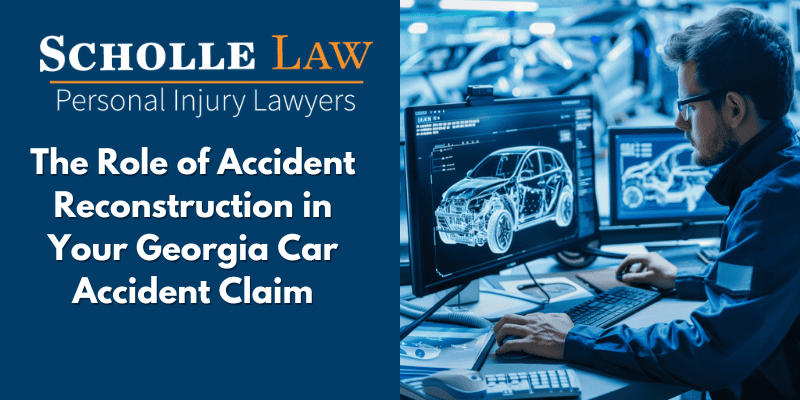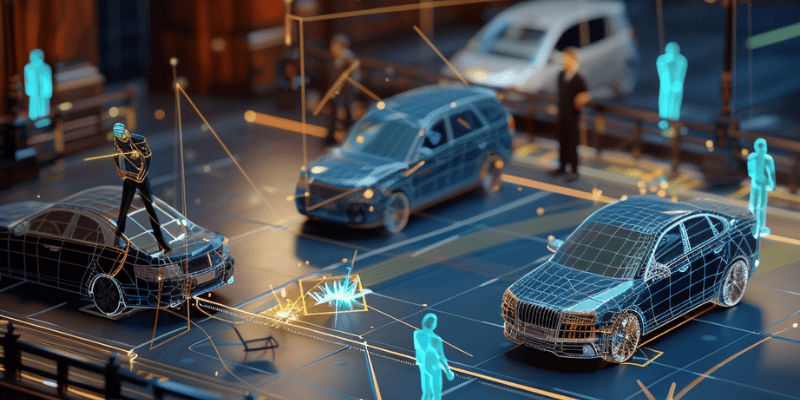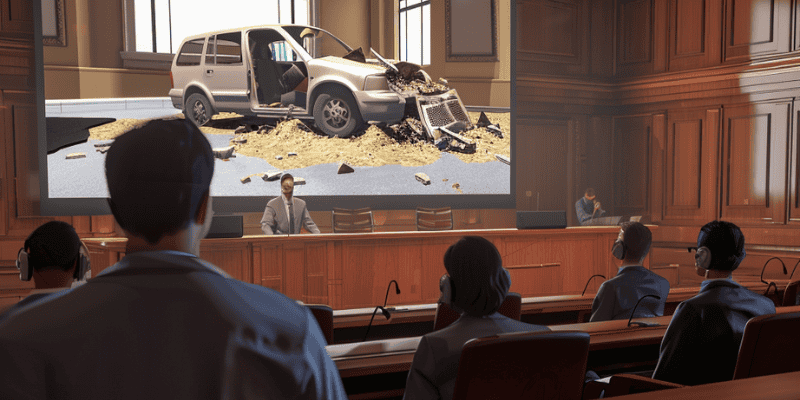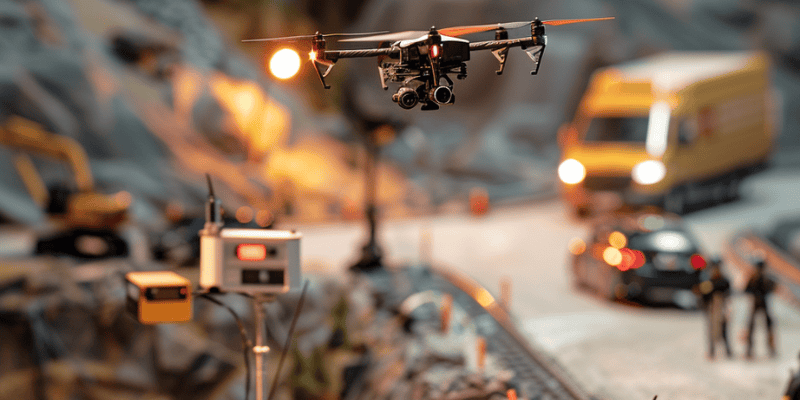4.9 Rating
Google REVIEWS
Leaders in Georgia Personal Injury Law Since 1995
The Role of Accident Reconstruction in Your Georgia Car Accident Claim
If you’re pursuing a car accident claim in Georgia, you may be asking ‘How can I prove my case?’ The answer lies in the role of accident reconstruction in your Georgia car accident claim: a critical process that provides a factual basis for your claim. This article dives into how these expert analyses help illustrate exactly what happened during your accident, offering compelling evidence that could be essential for a successful claim outcome.

Key Takeaways
- Accident reconstruction applies rigorous scientific methods and technology, such as simulations and analysis of physical evidence, to establish a detailed account of a vehicle crash—facilitating clarity in liability determinations and insurance negotiations.
- Expert testimony from accident reconstruction specialists, backed by strong credentials and advanced technologies like AI and 3D simulations, can significantly influence the outcomes of legal proceedings and insurance settlements.
- A collaborative approach between legal teams and accident reconstruction experts, including the integration of medical professional insights, is vital in constructing a compelling narrative to support the victim’s claim for fair compensation.

Deciphering the Crash: How Accident Reconstruction Unravels Your Georgia Car Accident
A car accident often results in a myriad of unanswered questions. Determining who is at fault and understanding how the accident occurred are fundamental aspects, particularly when seeking compensation for injuries or damages. This is where accident reconstruction comes into play. Accident reconstruction experts step in to unravel the chaos, meticulously piecing together the evidence to create a detailed accident scenario. They employ their specialized knowledge in fields like engineering and physics to conduct an objective analysis of car accidents. Their role extends beyond just deciphering the crash, as they work closely with legal teams to provide an objective account of what happened, which forms a powerful tool for fair and informed legal decisions.
The scope of accident reconstruction extends beyond comprehending how the accident happened to identifying the party at fault. With their extensive knowledge and thorough investigation, accident reconstructionists play a significant role in determining liability in car accident cases. After all, the outcome of your car accident case could very well hinge on their findings.
The Scientific Method in Action
Accident reconstruction is far from guesswork; it relies heavily on scientific methodologies. Reconstruction experts use Newton’s second law of motion, physics and mathematical formulas to understand the forces involved in a car accident. This scientific analysis helps them comprehend vehicle movements and assess the impact forces in a crash. But how do they manage to recreate the dynamics of a moving vehicle during the accident? The answer lies in specialized computer software simulations. These simulations, underpinned by the principles of physics and math, bring to life the sequence of events leading up to the crash. However, it’s not just about the software; it’s also about the experts who interpret and validate the data, ensuring accurate simulation results.
The rigorous scientific methodologies applied in accident reconstruction yield robust evidence. This scientific evidence holds great weight, especially when it comes to proving liability in car accident cases. It’s the thorough investigation and the rigorous scientific process that make the findings of accident reconstruction a compelling piece of evidence in a court of law.
Interpreting Physical Clues
A car accident typically leaves an array of physical evidence in its wake. Skid marks, tire tracks, vehicle damage – all these provide vital pieces of evidence that are pivotal in the accident reconstruction process. For instance, skid marks and tire tracks offer insights into the vehicles’ trajectories and speeds leading up to the collision. A thorough understanding of these physical clues helps in recreating the exact sequence of events leading to the accident.
But the physical evidence is not just about the accident scene. It also involves a close examination of the vehicles involved in the accident. Vehicle damage assessments can offer insights into the point of impact and the force involved in the accident. By understanding the severity of vehicle damage, reconstruction experts can establish the accident’s severity and its contributing factors.
Establishing a Timeline
Formulating a consistent sequence of events preceding a car accident is an indispensable aspect of accident reconstruction. By utilizing medical records and detailed scene data, reconstruction experts can reconstruct the sequence of events leading up to a car accident. In this process, they often uncover critical details that may have been missed in preliminary reports or witness accounts.
The analysis doesn’t stop at the accident scene. By analyzing the severity of injuries from medical records, experts can infer the force of impact and other crash factors. This information, when combined with 3D models and digital simulations, helps visualize and explain the timeline of events to a jury or insurance adjuster.
This comprehensive timeline, backed by scientific evidence, plays a crucial role in supporting car accident claims.
The Impact of Reconstruction Analysis on Proving Liability
Identifying the responsible party in a car accident can often turn into a complex conundrum. Accident reconstruction plays a significant role in solving this puzzle by providing objective evidence that is critical in determining which party is at fault. It digs into various aspects like:
- car speed
- sudden braking
- swerving
- driver attentiveness
These are all key factors in determining liability in personal injury claims.
Beyond establishing cause and effect, the impact of accident reconstruction extends to the courtroom as well. Expert testimony, a result of thorough accident reconstruction, can greatly influence the outcome of settlements or judgments by providing a clear and objective analysis of the crash event.
The role of accident reconstruction is even more heightened with the integration of artificial intelligence, leading to more precise evidence and enhancing the clarity and defensibility of liability determinations in car accident cases.

Dissecting Driver Behavior
Comprehending the driver’s actions during the crash is integral to accident reconstruction. To assess whether a driver was possibly distracted or was driving recklessly at the time of the crash, reconstructionists examine vehicle speed, braking patterns, and steering inputs. They also factor in the ability of a driver to recognize and adequately respond to hazards, whether it involves actions such as braking intensively, swerving to avoid an obstacle, or releasing the accelerator pedal in anticipation of danger.
Beyond immediate actions, accident reconstruction also analyzes broader aspects of driver behavior. Indicators such as:
- general awareness on the road
- potential distractions
- intoxication levels
- compliance with traffic rules
can all point to negligent or reckless driving. This dissection of driver behavior plays a crucial role in ascertaining liability in a car accident case.
Vehicle Interactions and Dynamics
Understanding the interactions and dynamics of vehicles involved in an accident is crucial in establishing the sequence of events leading up to the crash. Analysts study the movements and interplay between vehicles during an accident to ascertain the contributing factors to the crash. Insights gained from understanding vehicle dynamics provide a more nuanced view of the events leading up to and during the crash, thus aiding in the determination of potential fault.
The time taken by drivers to respond to hazards, like an adjacent vehicle merging or potential head-on collisions, plays a significant role in determining how accidents occur. It also aids in evaluating driver behavior during the accident reconstruction process.
Environmental Factors
The circumstances surrounding an accident significantly aid in deciphering how the crash occurred. Factors such as weather and road conditions are carefully considered in accident reconstructions to create an accurate depiction of the event. Experts examine environmental aspects like roadway configurations and visibility to assess their contribution to an accident.
It’s not just about the physical environment. Other environmental variations, such as lighting and weather conditions, help determine an appropriate driver response time during a crash reconstruction. Even factors like pavement conditions are inspected as part of the investigation to determine if poor road maintenance could have played a role in the accident. This thorough analysis of environmental factors contributes significantly to the overall understanding of the accident and the resulting liability determination.
Navigating Insurance Negotiations with Solid Evidence
In car accident claims, the struggle often extends beyond the courtroom to negotiations with insurance companies. Accident reconstruction can greatly strengthen your claim by delivering incontrovertible evidence, which can be pivotal in insurance negotiations. The evidence provided through comprehensive expert reports encapsulates the findings of accident reconstruction, serving as influential evidence during insurance negotiations.
With solid evidence in hand, victims can confidently challenge the insurance company’s narrative, potentially leading to a higher settlement offer. The scientific evidence combined with legal expertise creates a powerful case that can make all the difference in your car accident claim.
From Collision Analysis to Claims
Accident reconstruction entails deciphering intricate accident details and converting them into comprehensible evidence, providing crucial support for your claim. By analyzing collision data, reconstruction experts can counteract insurance company narratives by revealing the actual sequence of events. Moreover, comprehensive medical records document injuries and treatments, providing an objective link between the accident and the injuries, which is crucial in personal injury cases.
From the moment of collision to filing a claim, accident reconstruction serves as a guiding light, unraveling the complexities of the accident and providing solid evidence to support your claim. It is this clarity and objective analysis that allows victims to navigate insurance negotiations confidently.
Challenging the Insurance Company’s Narrative
Insurance companies may construct their own version of the accident events, which might not necessarily align with the victim’s perspective. Accident reconstruction can serve as an effective tool to disprove their assessments of fault, especially when countering practices like offering low settlements or disputing liability. By actively disputing traffic citations related to the car accident, it signals to the insurer that the client does not agree with the fault assigned and is willing to challenge it.
Attorneys build compelling narratives for accident claims by integrating factual data, expert opinions, and witness testimonies, underpinning the argument for the client’s side of the story. Challenging the insurance company’s narrative requires not only bringing forth new evidence but also reframing existing information to highlight the inaccuracies in the insurer’s fault findings.
Legal Leverage: Using Expert Testimony to Influence Legal Outcomes
The testimony of accident reconstruction specialists can be a linchpin in personal injury claims, elucidating factors that influence compensation and bolstering claims with substantial evidence. These experts play a key role in court by explaining accident reconstruction methodologies and interpreting complex technical details, helping juries understand the specifics of the accident.
The qualifications and presentation skills of expert witnesses can significantly sway court decisions, as their ability to communicate complex details clearly and provide solid evidence enhances their credibility with juries. With the advent of AI-generated data and simulations, expert testimony has gained a new dimension, contributing to its increasing impact on legal outcomes.

The Weight of Expert Opinions
The qualifications and expertise of an accident reconstruction expert are critical in determining the court’s acceptance of their testimony and findings. Their credibility and the weight of their opinions can greatly influence the outcome of a car accident case. The thoroughness of their investigation, their expertise, and their ability to present complex information in a simple, understandable manner can make all the difference in a legal battle.
Their testimony not only carries weight in court but also provides legal leverage in negotiations with insurance companies. Their expert analysis and findings can effectively counter the narratives put forth by insurance companies and help victims secure fair compensation for their losses.
Visual Aids and Simulations
In the courtroom, it’s not just about what you say, but also how you present it. Advanced visual aids, such as 3D models and computer-generated simulations, can play a crucial role in making complex accident scenarios more understandable. In court presentations, expert witnesses can bolster their testimony with the help of these visual aids to clarify complex accident scenarios.
Advanced technological tools such as virtual reality simulations and digital reconstructions are increasingly being used to provide juries with an engaging and comprehensive understanding of the evidence. The use of Computer-aided design (CAD) programs to recreate the accident scene in three dimensions creates a powerful visual evidence that can aid in personal injury lawsuits.

Harnessing Advanced Technology in Modern Accident Reconstruction
Advanced technology has induced significant transformations in the field of accident reconstruction. Tools like forensic science techniques, automotive engineers’ tools, and advanced software are integral to modern accident reconstruction efforts. A variety of advanced tools, including drones, 3D modeling, and laser scanning are used to enhance the precision of documenting and analyzing crash sites.
The role of technology has been instrumental in improving the precision and reliability of accident reconstruction findings. By harnessing advanced technology, accident reconstruction experts can provide more accurate and defensible evidence, enhancing the clarity of liability determinations and supporting the pursuit of fair compensation.
Data Collection Tools
Modern technology has provided accident reconstruction experts with state-of-the-art tools to recover electronic data and video recordings from vehicles after a collision. Event data recorders and video analyses provide insights into a driver’s response times during a crash, which are vital for understanding how the incident unfolded.
Moreover, tools like:
- laser scanning technology
- 3D scanners
- drones
- AI
are employed to capture precise measurements of the accident scene. The use of drones allows experts to gather detailed data about the scene in three dimensions. Even AI is playing a role in accident reconstruction, analyzing multiple variables in complex multi-vehicle accidents to predict a range of possible outcomes.
Simulation Software
Recreating a car accident involves more than just analyzing physical evidence and witness statements. It requires:
- Recreating the vehicle movements
- Calculating impact forces involved in the accident
- Using simulation software, powered by mathematical and physics calculations, to replicate the movement of vehicles in the moments before an accident.
AI algorithms analyze data from traffic cameras, vehicle telematics, and GPS tracking to create detailed reconstructions of accidents. In a rear-end collision, for instance, simulation software is used to calculate the impact force by subtracting the speed of the vehicle struck from the speed of the striking vehicle. This advanced software enables a deeper understanding of the accident dynamics and provides solid evidence that can support car accident claims.
Your Legal Team and Accident Reconstruction Specialists Working Together
A synergistic partnership between a legal team and accident reconstruction specialists forms the cornerstone of car accident claims. It brings together scientific evidence with legal expertise, establishing causation, liability, and the damages suffered. Securing expert legal assistance is critical for a car accident case as an attorney must comprehend accident reconstruction techniques to effectively advocate for the victim.
At Scholle Law, our personal injury attorneys have networks of reliable expert witnesses who can be instrumental in maximizing compensation for clients. With their extensive experience and deep understanding of accident reconstruction, our legal team can advocate effectively for your rights, helping you navigate the complex landscape of car accident claims. Some of the expert witnesses we work with include:
- Accident reconstruction experts
- Medical experts
- Forensic experts
- Engineering experts
- Vocational experts
These experts can provide valuable testimony and evidence to support your claim and ensure that you receive the compensation you deserve.
Coordinating with Medical Professionals
Accident reconstruction isn’t an isolated process. It frequently necessitates close collaboration with medical professionals who contribute vital information about the severity of injuries and their treatment for accident victims. Medical records that document injuries and treatments provide an objective link between the accident and the injuries, which is crucial in personal injury cases.
Expert witnesses with credible backgrounds, such as medical experts, provide specialized testimony that can sway a jury’s decision. They emphasize the extent of injuries and their impacts, which strengthens the connection between the injuries and the accident. By offering objective evidence of injuries related to the accident, medical records and professional opinions complement the physical evidence gathered by reconstruction experts, providing a comprehensive understanding of the accident’s impact.
Crafting a Compelling Narrative
Accident reconstruction encompasses:
- Collection and analysis of evidence
- Creation of a persuasive narrative that corroborates the victim’s account of events
- Collaboration between reconstructionists and the legal team to piece together physical evidence and witness testimonies
- Integration of findings with witness statements to craft a narrative that advocates for the victim
This persuasive narrative, backed by solid evidence, aligns with the victim’s version of events, bolstering their argument for compensation, including lost wages.
Summary
Accident reconstruction plays a pivotal role in car accident claims, providing a comprehensive understanding of the accident and establishing liability. It utilizes scientific methods, advanced technology, and expert testimony to analyze physical evidence, driver behavior, vehicle dynamics, and environmental factors. This objective analysis provides solid evidence that can influence legal outcomes, challenge the insurance company’s narrative, and strengthen car accident compensation claims. With the right legal team from Scholle Law and accident reconstruction specialists working together, victims can navigate the complex landscape of car accident claims and seek the fair compensation they deserve.
Frequently Asked Questions
What is accident reconstruction?
Accident reconstruction is a scientific method used to understand how and why a car accident occurred by piecing together evidence from the accident scene, witness statements, and other available data. It provides a detailed analysis of the events leading up to the accident and can help determine liability.
How does accident reconstruction help in car accident claims?
Accident reconstruction helps in car accident claims by providing solid evidence to support the sequence of events leading to the accident, determine fault, and influence legal outcomes. It can be instrumental in establishing key facts for a successful claim.
What role do expert witnesses play in accident reconstruction?
Expert witnesses, such as accident reconstruction specialists, provide expert testimony in court, explaining the methodologies and findings of accident reconstruction to influence the case’s outcome positively.
How does technology aid in accident reconstruction?
Technology aids in accident reconstruction by utilizing tools such as drones, 3D modeling, laser scanning, and simulation software to improve the accuracy of documenting and analyzing crash sites, as well as recreating vehicle movements and calculating impact forces.
How does a legal team work with accident reconstruction specialists in a car accident case?
A legal team at Scholle Law collaborates closely with accident reconstruction specialists to interpret findings and present a compelling narrative that supports the client’s version of events. Together, they gather and analyze evidence, challenge the insurance company’s narrative, and advocate for fair compensation.
